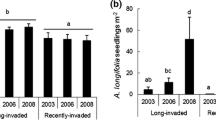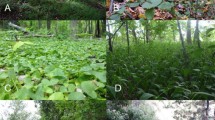Abstract
Knowing which species will become invasive has been the holy grail of invasion biology. A survey of woody plants was conducted in 2001 on an island (Isla Victoria) where 135 non-native woody plant species had been introduced 80 years previously. The survey showed that nearly 10% of introduced species had spread further than 100 m from the original sites. For some introduced species on this island longer time lags between introduction and invasion (or further spread) could be at play. To test if new invasions have begun since the original survey or if ongoing invasions have spread further, we repeated the survey a decade later. The proportion of introduced species that became invasive did not increase between surveys, suggesting that longer time lags may not reveal major invasions from new species on this island. However, we found that the relative frequency of taller individuals (above 2 m) has increased, suggesting a change in age structure of these invasive populations. Further, we found that woody invader densities and maximum heights have increased since the original survey, suggesting that woody plant invasion is progressing, and for some species even accelerating. These results highlight the importance of research on how long invasions of long-lived woody plants can take, providing key data to guide long-term monitoring of sites with multiple non-native plant introductions.





Similar content being viewed by others
Data availability
The data from this study will be made available on reasonable request.
References
Aagaard K, Lockwood J (2014) Exotic birds show lags in population growth. Divers Distrib 20:547–554. https://doi.org/10.1111/ddi.12175
Blackburn TM, Pyšek P, Bacher S et al (2011) A proposed unified framework for biological invasions. Trends Ecol Evol 26:333–339. https://doi.org/10.1016/j.tree.2011.03.023
Cook RD, Weisberg S (1982) Residuals and influence in regression. Chapman and Hall
Crooks JA, Soulé ME (1999) Lag times in population explosions of invasive species: causes and implications. In: Sandlund OT et al (eds) Invasive species and biodiversity management. Kluwer Academic Publishers, pp 103–125
Ferguson DE, Carlson CE (2010) Height-age relationships for regeneration-size trees in the northern Rocky Mountains, USA. Research paper RMRS-RP-82WWW. USDA, Forest Service, Rocky Mountain Research Station
Hayward J, Horton TR, Nuñez MA (2015) Ectomycorrhizal fungal communities co-invading with Pinaceae host plants in Argentina: Gringos bajo el bosque. New Phytol 208:497–506. https://doi.org/10.1111/nph.13453
Kowarik I (1995) Time lags in biological invasions with regard to the success and failure of alien species. In: Pysek P, Prach K, Rejmánek M, Wade M (eds) Plant invasions, general aspects and social problems. SPB Academic Publishing, pp 15–38
Langdon B, Pauchard A, Aguayo M (2010) Pinus contorta invasion in the Chilean Patagonia: local patterns in a global context. Biol Invasions 12:3961–3971. https://doi.org/10.1007/s10530-010-9817-5
Nuñez MA, Paritsis J (2018) How are monospecific stands of invasive trees formed? Spatio-temporal evidence from Douglas fir invasions. AoB Plants 10:ply041. https://doi.org/10.1093/aobpla/ply041
Nuñez MA, Relva MA, Simberloff D (2008a) Enemy release or invasional meltdown? Deer preference for exotic and native trees on Isla Victoria, Argentina. Austral Ecol 33:317–323. https://doi.org/10.1111/j.1442-9993.2007.01819.x
Nuñez MA, Simberloff D, Relva MA (2008b) Seed predation as a barrier to alien conifer invasions. Biol Invasions 10:1389–1398. https://doi.org/10.1007/s10530-007-9214-x
Nuñez MA, Horton TR, Simberloff D (2009) Lack of belowground mutualisms hinders Pinaceae invasions. Ecology 90:2352–2359. https://doi.org/10.1890/08-2139.1
Quinn GP, Keough MJ (2002) Experimental design and data analysis for biologists. Cambridge University Press
R Development Core Team (2021) R: a language and environment for statistical computing
Relva MA, Nuñez MA, Simberloff D (2010) Introduced deer reduce native plant cover and facilitate invasion of non-native tree species: evidence for invasional meltdown. Biol Invasions 12:303–311. https://doi.org/10.1007/s10530-009-9623-0
Richardson DM, Pyšek P, Rejmánek M et al (2000) Naturalization and invasion of alien plants: concepts and definitions. Divers Distrib 6:93–107. https://doi.org/10.1046/j.1472-4642.2000.00083.x
Satti P, Mazzarino MJ, Roselli L, Crego P (2007) Factors affecting soil P dynamics in temperate volcanic soils of southern Argentina. Geoderma 139:229–240. https://doi.org/10.1016/j.geoderma.2007.02.005
Simberloff D, Relva MA, Nuñez M (2002) Gringos en el bosque: Introduced tree invasion in a native Nothofagus/Austrocedrus forest. Biol Invasions 4:35–53. https://doi.org/10.1023/A:1020576408884
Venables WN, Ripley BD (2002) Modern applied statistics with S. Springer, New York
Williamson MH, Fitter A (1996) The characters of successful invaders. Biol Conserv 78:163–170. https://doi.org/10.1016/0006-3207(96)00025-0
Williamson MH, Brown KC, Holdgate MW et al (1986) The analysis and modelling of british invasions [and discussion]. Philos Trans R Soc Lond B Biol Sci 314:505–522
Acknowledgments
We thank two anonymous reviewers for their constructive feedback, which helped us improve this manuscript.
Funding
This work was supported by the National Agency of Scientific and Technologic Promotion (AGENCIA) grant “PICT 2018 329”.
Author information
Authors and Affiliations
Corresponding author
Ethics declarations
Conflict of interest
The authors have no relevant financial or non-financial interests to disclose.
Additional information
Publisher's Note
Springer Nature remains neutral with regard to jurisdictional claims in published maps and institutional affiliations.
Rights and permissions
Springer Nature or its licensor (e.g. a society or other partner) holds exclusive rights to this article under a publishing agreement with the author(s) or other rightsholder(s); author self-archiving of the accepted manuscript version of this article is solely governed by the terms of such publishing agreement and applicable law.
About this article
Cite this article
Moyano, J., Simberloff, D., Relva, M.A. et al. Increasing tree invasion on Isla Victoria: 10 years after the original “gringos en el bosque” study. Biol Invasions 25, 3025–3031 (2023). https://doi.org/10.1007/s10530-023-03103-6
Received:
Accepted:
Published:
Issue Date:
DOI: https://doi.org/10.1007/s10530-023-03103-6




